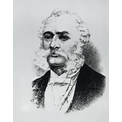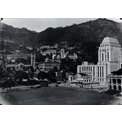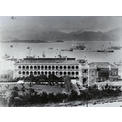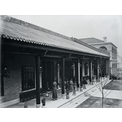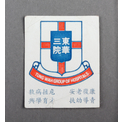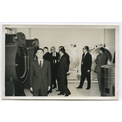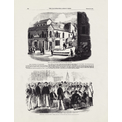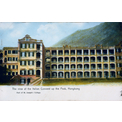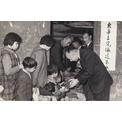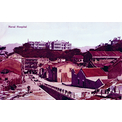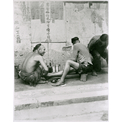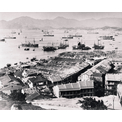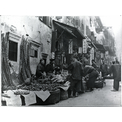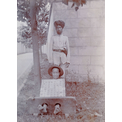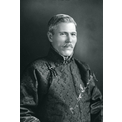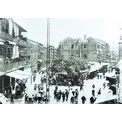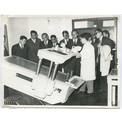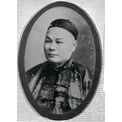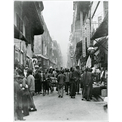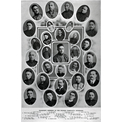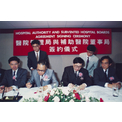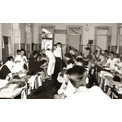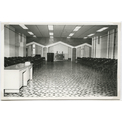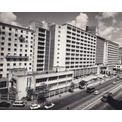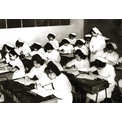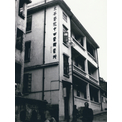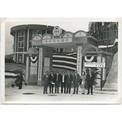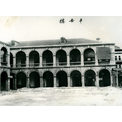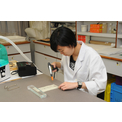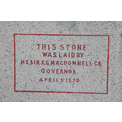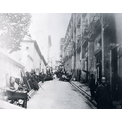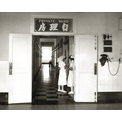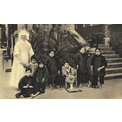 Collections
Collections Hong Kong, Benevolent City: Tung Wah and the Growth of Chinese Communities
Hong Kong, Benevolent City: Tung Wah and the Growth of Chinese Communities All Items
All Items Images
Images
Sei Wan Yu Lan Kung So in Sheung Wan
Looking south from Hollywood Road towards Square Street and Ladder Street; taken around 1870. On the left of the photograph, next to the Man Mo Temple, is the Sei Wan Yu Lan Kung So. In the early years following Hong Kong's opening as a trading port, the British paid no attention to the welfare of Chinese people. To support one another, Chinese people formed organisations on the basis of geographical, blood, industry or neighbourhood ties, and some organisations set up kung so (communal halls) so that people could gather to discuss the affairs of the day.
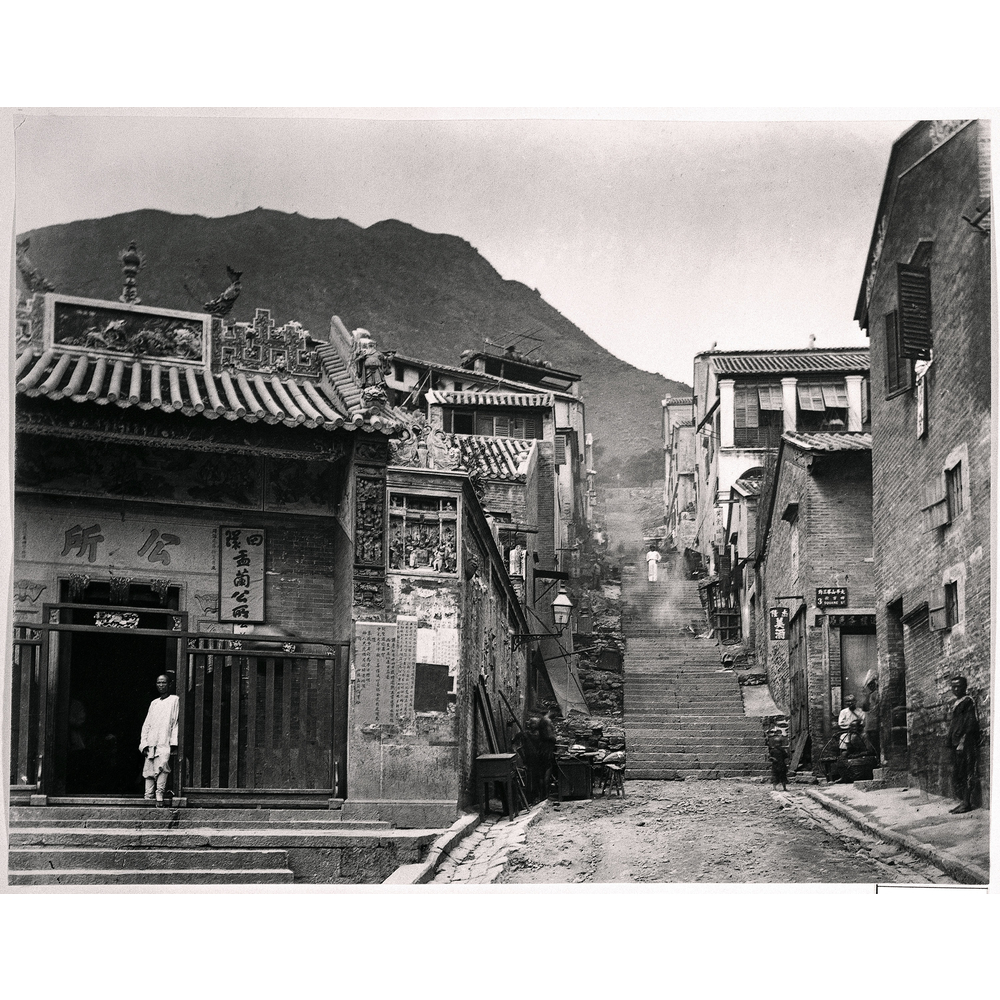
| Date | c.1870 |
| Place | Hong Kong Island/Central and Western District/Sheung Wan/(Street)/Man Mo Temple;Hong Kong Island/Central and Western District/Sheung Wan/Ladder Street |
| Material Type | Image |
| Collection | Hong Kong, Benevolent City: Tung Wah and the Growth of Chinese Communities |
| Source | Hong Kong Museum of History. Image Reference No.: P1999.5.32 |
| Repository | Hong Kong Museum of History |
| Note to Copyright | Permission for use in Hong Kong Memory is given by Hong Kong Museum of History |
| Accession No. | lcs-twgh-0016 |
Sei Wan Yu Lan Kung So in Sheung Wan
Looking south from Hollywood Road towards Square Street and Ladder Street; taken around 1870. On the left of the photograph, next to the Man Mo Temple, is the Sei Wan Yu Lan Kung So. In the early years following Hong Kong's opening as a trading port, the British paid no attention to the welfare of Chinese people. To support one another, Chinese people formed organisations on the basis of geographical, blood, industry or neighbourhood ties, and some organisations set up kung so (communal halls) so that people could gather to discuss the affairs of the day.
| Date | c.1870 |
| Place | Hong Kong Island/Central and Western District/Sheung Wan/(Street)/Man Mo Temple;Hong Kong Island/Central and Western District/Sheung Wan/Ladder Street |
| Material Type | Image |
| Collection | Hong Kong, Benevolent City: Tung Wah and the Growth of Chinese Communities |
| Source | Hong Kong Museum of History. Image Reference No.: P1999.5.32 |
| Repository | Hong Kong Museum of History |
| Note to Copyright | Permission for use in Hong Kong Memory is given by Hong Kong Museum of History |
| Accession No. | lcs-twgh-0016 |
Sei Wan Yu Lan Kung So in Sheung Wan
Looking south from Hollywood Road towards Square Street and Ladder Street; taken around 1870. On the left of the photograph, next to the Man Mo Temple, is the Sei Wan Yu Lan Kung So. In the early years following Hong Kong's opening as a trading port, the British paid no attention to the welfare of Chinese people. To support one another, Chinese people formed organisations on the basis of geographical, blood, industry or neighbourhood ties, and some organisations set up kung so (communal halls) so that people could gather to discuss the affairs of the day.
| Date | c.1870 |
| Place | Hong Kong Island/Central and Western District/Sheung Wan/(Street)/Man Mo Temple;Hong Kong Island/Central and Western District/Sheung Wan/Ladder Street |
| Material Type | Image |
| Collection | Hong Kong, Benevolent City: Tung Wah and the Growth of Chinese Communities |
| Source | Hong Kong Museum of History. Image Reference No.: P1999.5.32 |
| Repository | Hong Kong Museum of History |
| Note to Copyright | Permission for use in Hong Kong Memory is given by Hong Kong Museum of History |
| Accession No. | lcs-twgh-0016 |
Sei Wan Yu Lan Kung So in Sheung Wan
Looking south from Hollywood Road towards Square Street and Ladder Street; taken around 1870. On the left of the photograph, next to the Man Mo Temple, is the Sei Wan Yu Lan Kung So. In the early years following Hong Kong's opening as a trading port, the British paid no attention to the welfare of Chinese people. To support one another, Chinese people formed organisations on the basis of geographical, blood, industry or neighbourhood ties, and some organisations set up kung so (communal halls) so that people could gather to discuss the affairs of the day.
| Date | c.1870 |
| Place | Hong Kong Island/Central and Western District/Sheung Wan/(Street)/Man Mo Temple;Hong Kong Island/Central and Western District/Sheung Wan/Ladder Street |
| Material Type | Image |
| Collection | Hong Kong, Benevolent City: Tung Wah and the Growth of Chinese Communities |
| Source | Hong Kong Museum of History. Image Reference No.: P1999.5.32 |
| Repository | Hong Kong Museum of History |
| Note to Copyright | Permission for use in Hong Kong Memory is given by Hong Kong Museum of History |
| Accession No. | lcs-twgh-0016 |
Sei Wan Yu Lan Kung So in Sheung Wan
Looking south from Hollywood Road towards Square Street and Ladder Street; taken around 1870. On the left of the photograph, next to the Man Mo Temple, is the Sei Wan Yu Lan Kung So. In the early years following Hong Kong's opening as a trading port, the British paid no attention to the welfare of Chinese people. To support one another, Chinese people formed organisations on the basis of geographical, blood, industry or neighbourhood ties, and some organisations set up kung so (communal halls) so that people could gather to discuss the affairs of the day.
| Date | c.1870 |
| Material Type | Image |
| Collection | Hong Kong, Benevolent City: Tung Wah and the Growth of Chinese Communities |
| Source | Hong Kong Museum of History. Image Reference No.: P1999.5.32 |
| Repository | Hong Kong Museum of History |
| Note to Copyright | Permission for use in Hong Kong Memory is given by Hong Kong Museum of History |
| Accession No. | lcs-twgh-0016 |
Sei Wan Yu Lan Kung So in Sheung Wan
Looking south from Hollywood Road towards Square Street and Ladder Street; taken around 1870. On the left of the photograph, next to the Man Mo Temple, is the Sei Wan Yu Lan Kung So. In the early years following Hong Kong's opening as a trading port, the British paid no attention to the welfare of Chinese people. To support one another, Chinese people formed organisations on the basis of geographical, blood, industry or neighbourhood ties, and some organisations set up kung so (communal halls) so that people could gather to discuss the affairs of the day.
| Date | c.1870 |
| Place | Hong Kong Island/Central and Western District/Sheung Wan/(Street)/Man Mo Temple;Hong Kong Island/Central and Western District/Sheung Wan/Ladder Street |
| Material Type | Image |
| Collection | Hong Kong, Benevolent City: Tung Wah and the Growth of Chinese Communities |
| Source | Hong Kong Museum of History. Image Reference No.: P1999.5.32 |
| Repository | Hong Kong Museum of History |
| Note to Copyright | Permission for use in Hong Kong Memory is given by Hong Kong Museum of History |
| Accession No. | lcs-twgh-0016 |
Sei Wan Yu Lan Kung So in Sheung Wan
Looking south from Hollywood Road towards Square Street and Ladder Street; taken around 1870. On the left of the photograph, next to the Man Mo Temple, is the Sei Wan Yu Lan Kung So. In the early years following Hong Kong's opening as a trading port, the British paid no attention to the welfare of Chinese people. To support one another, Chinese people formed organisations on the basis of geographical, blood, industry or neighbourhood ties, and some organisations set up kung so (communal halls) so that people could gather to discuss the affairs of the day.
| Date | c.1870 |
| Place | Hong Kong Island/Central and Western District/Sheung Wan/(Street)/Man Mo Temple;Hong Kong Island/Central and Western District/Sheung Wan/Ladder Street |
| Material Type | Image |
| Collection | Hong Kong, Benevolent City: Tung Wah and the Growth of Chinese Communities |
| Source | Hong Kong Museum of History. Image Reference No.: P1999.5.32 |
| Repository | Hong Kong Museum of History |
| Note to Copyright | Permission for use in Hong Kong Memory is given by Hong Kong Museum of History |
| Accession No. | lcs-twgh-0016 |
Sei Wan Yu Lan Kung So in Sheung Wan
Looking south from Hollywood Road towards Square Street and Ladder Street; taken around 1870. On the left of the photograph, next to the Man Mo Temple, is the Sei Wan Yu Lan Kung So. In the early years following Hong Kong's opening as a trading port, the British paid no attention to the welfare of Chinese people. To support one another, Chinese people formed organisations on the basis of geographical, blood, industry or neighbourhood ties, and some organisations set up kung so (communal halls) so that people could gather to discuss the affairs of the day.
| Date of Death | c.1870 |
| Place | Hong Kong Island/Central and Western District/Sheung Wan/(Street)/Man Mo Temple;Hong Kong Island/Central and Western District/Sheung Wan/Ladder Street |
| Material Type | Image |
| Collection | Hong Kong, Benevolent City: Tung Wah and the Growth of Chinese Communities |
| Source | Hong Kong Museum of History. Image Reference No.: P1999.5.32 |
| Repository | Hong Kong Museum of History |
| Note to Copyright | Permission for use in Hong Kong Memory is given by Hong Kong Museum of History |
| Accession No. | lcs-twgh-0016 |
Sei Wan Yu Lan Kung So in Sheung Wan
Looking south from Hollywood Road towards Square Street and Ladder Street; taken around 1870. On the left of the photograph, next to the Man Mo Temple, is the Sei Wan Yu Lan Kung So. In the early years following Hong Kong's opening as a trading port, the British paid no attention to the welfare of Chinese people. To support one another, Chinese people formed organisations on the basis of geographical, blood, industry or neighbourhood ties, and some organisations set up kung so (communal halls) so that people could gather to discuss the affairs of the day.
| Date | c.1870 |
| Material Type | Image |
| Collection | Hong Kong, Benevolent City: Tung Wah and the Growth of Chinese Communities |
| Source | Hong Kong Museum of History. Image Reference No.: P1999.5.32 |
| Note to Copyright | Permission for use in Hong Kong Memory is given by Hong Kong Museum of History |
| Accession No. | lcs-twgh-0016 |
Sei Wan Yu Lan Kung So in Sheung Wan
Looking south from Hollywood Road towards Square Street and Ladder Street; taken around 1870. On the left of the photograph, next to the Man Mo Temple, is the Sei Wan Yu Lan Kung So. In the early years following Hong Kong's opening as a trading port, the British paid no attention to the welfare of Chinese people. To support one another, Chinese people formed organisations on the basis of geographical, blood, industry or neighbourhood ties, and some organisations set up kung so (communal halls) so that people could gather to discuss the affairs of the day.
| Date | c.1870 |
| Material Type | Image |
| Place | Hong Kong Island/Central and Western District/Sheung Wan/(Street)/Man Mo Temple;Hong Kong Island/Central and Western District/Sheung Wan/Ladder Street |
| Collection | Hong Kong, Benevolent City: Tung Wah and the Growth of Chinese Communities |
| Source | Hong Kong Museum of History. Image Reference No.: P1999.5.32 |
| Repository | Hong Kong Museum of History |
| Note to Copyright | Permission for use in Hong Kong Memory is given by Hong Kong Museum of History |
| Accession No. | lcs-twgh-0016 |
Sei Wan Yu Lan Kung So in Sheung Wan
Looking south from Hollywood Road towards Square Street and Ladder Street; taken around 1870. On the left of the photograph, next to the Man Mo Temple, is the Sei Wan Yu Lan Kung So. In the early years following Hong Kong's opening as a trading port, the British paid no attention to the welfare of Chinese people. To support one another, Chinese people formed organisations on the basis of geographical, blood, industry or neighbourhood ties, and some organisations set up kung so (communal halls) so that people could gather to discuss the affairs of the day.
| Date | c.1870 |
| Place | Hong Kong Island/Central and Western District/Sheung Wan/(Street)/Man Mo Temple;Hong Kong Island/Central and Western District/Sheung Wan/Ladder Street |
| Material Type | Image |
| Collection | Hong Kong, Benevolent City: Tung Wah and the Growth of Chinese Communities |
| Source | Hong Kong Museum of History. Image Reference No.: P1999.5.32 |
| Repository | Hong Kong Museum of History |
| Note to Copyright | Permission for use in Hong Kong Memory is given by Hong Kong Museum of History |
| Accession No. | lcs-twgh-0016 |
Sei Wan Yu Lan Kung So in Sheung Wan
Looking south from Hollywood Road towards Square Street and Ladder Street; taken around 1870. On the left of the photograph, next to the Man Mo Temple, is the Sei Wan Yu Lan Kung So. In the early years following Hong Kong's opening as a trading port, the British paid no attention to the welfare of Chinese people. To support one another, Chinese people formed organisations on the basis of geographical, blood, industry or neighbourhood ties, and some organisations set up kung so (communal halls) so that people could gather to discuss the affairs of the day.
| Date | c.1870 |
| Place | Hong Kong Island/Central and Western District/Sheung Wan/(Street)/Man Mo Temple;Hong Kong Island/Central and Western District/Sheung Wan/Ladder Street |
| Material Type | Image |
| Collection | Hong Kong, Benevolent City: Tung Wah and the Growth of Chinese Communities |
| Source | Hong Kong Museum of History. Image Reference No.: P1999.5.32 |
| Repository | Hong Kong Museum of History |
| Note to Copyright | Permission for use in Hong Kong Memory is given by Hong Kong Museum of History |
| Accession No. | lcs-twgh-0016 |
Sei Wan Yu Lan Kung So in Sheung Wan
Looking south from Hollywood Road towards Square Street and Ladder Street; taken around 1870. On the left of the photograph, next to the Man Mo Temple, is the Sei Wan Yu Lan Kung So. In the early years following Hong Kong's opening as a trading port, the British paid no attention to the welfare of Chinese people. To support one another, Chinese people formed organisations on the basis of geographical, blood, industry or neighbourhood ties, and some organisations set up kung so (communal halls) so that people could gather to discuss the affairs of the day.
| Date | c.1870 |
| Place | Hong Kong Island/Central and Western District/Sheung Wan/(Street)/Man Mo Temple;Hong Kong Island/Central and Western District/Sheung Wan/Ladder Street |
| Material Type | Image |
| Collection | Hong Kong, Benevolent City: Tung Wah and the Growth of Chinese Communities |
| Source | Hong Kong Museum of History. Image Reference No.: P1999.5.32 |
| Repository | Hong Kong Museum of History |
| Note to Copyright | Permission for use in Hong Kong Memory is given by Hong Kong Museum of History |
| Accession No. | lcs-twgh-0016 |
Sei Wan Yu Lan Kung So in Sheung Wan
Looking south from Hollywood Road towards Square Street and Ladder Street; taken around 1870. On the left of the photograph, next to the Man Mo Temple, is the Sei Wan Yu Lan Kung So. In the early years following Hong Kong's opening as a trading port, the British paid no attention to the welfare of Chinese people. To support one another, Chinese people formed organisations on the basis of geographical, blood, industry or neighbourhood ties, and some organisations set up kung so (communal halls) so that people could gather to discuss the affairs of the day.
| Date | c.1870 |
| Place | Hong Kong Island/Central and Western District/Sheung Wan/(Street)/Man Mo Temple;Hong Kong Island/Central and Western District/Sheung Wan/Ladder Street |
| Material Type | Image |
| Collection | Hong Kong, Benevolent City: Tung Wah and the Growth of Chinese Communities |
| Source | Hong Kong Museum of History. Image Reference No.: P1999.5.32 |
| Repository | Hong Kong Museum of History |
| Note to Copyright | Permission for use in Hong Kong Memory is given by Hong Kong Museum of History |
| Accession No. | lcs-twgh-0016 |
Sei Wan Yu Lan Kung So in Sheung Wan
Looking south from Hollywood Road towards Square Street and Ladder Street; taken around 1870. On the left of the photograph, next to the Man Mo Temple, is the Sei Wan Yu Lan Kung So. In the early years following Hong Kong's opening as a trading port, the British paid no attention to the welfare of Chinese people. To support one another, Chinese people formed organisations on the basis of geographical, blood, industry or neighbourhood ties, and some organisations set up kung so (communal halls) so that people could gather to discuss the affairs of the day.
| Date | c.1870 |
| Place | Hong Kong Island/Central and Western District/Sheung Wan/(Street)/Man Mo Temple;Hong Kong Island/Central and Western District/Sheung Wan/Ladder Street |
| Material Type | Image |
| Collection | Hong Kong, Benevolent City: Tung Wah and the Growth of Chinese Communities |
| Source | Hong Kong Museum of History. Image Reference No.: P1999.5.32 |
| Repository | Hong Kong Museum of History |
| Note to Copyright | Permission for use in Hong Kong Memory is given by Hong Kong Museum of History |
| Accession No. | lcs-twgh-0016 |
Sei Wan Yu Lan Kung So in Sheung Wan
Looking south from Hollywood Road towards Square Street and Ladder Street; taken around 1870. On the left of the photograph, next to the Man Mo Temple, is the Sei Wan Yu Lan Kung So. In the early years following Hong Kong's opening as a trading port, the British paid no attention to the welfare of Chinese people. To support one another, Chinese people formed organisations on the basis of geographical, blood, industry or neighbourhood ties, and some organisations set up kung so (communal halls) so that people could gather to discuss the affairs of the day.
| Date | c.1870 |
| Place | Hong Kong Island/Central and Western District/Sheung Wan/(Street)/Man Mo Temple;Hong Kong Island/Central and Western District/Sheung Wan/Ladder Street |
| Material Type | Image |
| Collection | Hong Kong, Benevolent City: Tung Wah and the Growth of Chinese Communities |
| Source | Hong Kong Museum of History. Image Reference No.: P1999.5.32 |
| Repository | Hong Kong Museum of History |
| Note to Copyright | Permission for use in Hong Kong Memory is given by Hong Kong Museum of History |
| Accession No. | lcs-twgh-0016 |
Sei Wan Yu Lan Kung So in Sheung Wan
Looking south from Hollywood Road towards Square Street and Ladder Street; taken around 1870. On the left of the photograph, next to the Man Mo Temple, is the Sei Wan Yu Lan Kung So. In the early years following Hong Kong's opening as a trading port, the British paid no attention to the welfare of Chinese people. To support one another, Chinese people formed organisations on the basis of geographical, blood, industry or neighbourhood ties, and some organisations set up kung so (communal halls) so that people could gather to discuss the affairs of the day.
| Date | c.1870 |
| Place | Hong Kong Island/Central and Western District/Sheung Wan/(Street)/Man Mo Temple;Hong Kong Island/Central and Western District/Sheung Wan/Ladder Street |
| Material Type | Image |
| Collection | Hong Kong, Benevolent City: Tung Wah and the Growth of Chinese Communities |
| Source | Hong Kong Museum of History. Image Reference No.: P1999.5.32 |
| Repository | Hong Kong Museum of History |
| Note to Copyright | Permission for use in Hong Kong Memory is given by Hong Kong Museum of History |
| Accession No. | lcs-twgh-0016 |
Sei Wan Yu Lan Kung So in Sheung Wan
Looking south from Hollywood Road towards Square Street and Ladder Street; taken around 1870. On the left of the photograph, next to the Man Mo Temple, is the Sei Wan Yu Lan Kung So. In the early years following Hong Kong's opening as a trading port, the British paid no attention to the welfare of Chinese people. To support one another, Chinese people formed organisations on the basis of geographical, blood, industry or neighbourhood ties, and some organisations set up kung so (communal halls) so that people could gather to discuss the affairs of the day.
| Date | c.1870 |
| Place | Hong Kong Island/Central and Western District/Sheung Wan/(Street)/Man Mo Temple;Hong Kong Island/Central and Western District/Sheung Wan/Ladder Street |
| Material Type | Image |
| Collection | Hong Kong, Benevolent City: Tung Wah and the Growth of Chinese Communities |
| Source | Hong Kong Museum of History. Image Reference No.: P1999.5.32 |
| Repository | Hong Kong Museum of History |
| Note to Copyright | Permission for use in Hong Kong Memory is given by Hong Kong Museum of History |
| Accession No. | lcs-twgh-0016 |
Copyright © 2012 Hong Kong Memory

